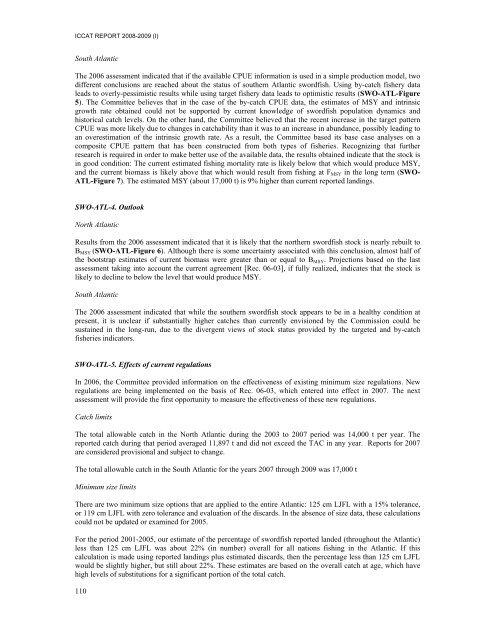REPORT OF THE STANDING COMMITTEE ON RESEARCH ... - Iccat
REPORT OF THE STANDING COMMITTEE ON RESEARCH ... - Iccat
REPORT OF THE STANDING COMMITTEE ON RESEARCH ... - Iccat
Create successful ePaper yourself
Turn your PDF publications into a flip-book with our unique Google optimized e-Paper software.
ICCAT <strong>REPORT</strong> 2008-2009 (I)South AtlanticThe 2006 assessment indicated that if the available CPUE information is used in a simple production model, twodifferent conclusions are reached about the status of southern Atlantic swordfish. Using by-catch fishery dataleads to overly-pessimistic results while using target fishery data leads to optimistic results (SWO-ATL-Figure5). The Committee believes that in the case of the by-catch CPUE data, the estimates of MSY and intrinsicgrowth rate obtained could not be supported by current knowledge of swordfish population dynamics andhistorical catch levels. On the other hand, the Committee believed that the recent increase in the target patternCPUE was more likely due to changes in catchability than it was to an increase in abundance, possibly leading toan overestimation of the intrinsic growth rate. As a result, the Committee based its base case analyses on acomposite CPUE pattern that has been constructed from both types of fisheries. Recognizing that furtherresearch is required in order to make better use of the available data, the results obtained indicate that the stock isin good condition: The current estimated fishing mortality rate is likely below that which would produce MSY,and the current biomass is likely above that which would result from fishing at F MSY in the long term (SWO-ATL-Figure 7). The estimated MSY (about 17,000 t) is 9% higher than current reported landings.SWO-ATL-4. OutlookNorth AtlanticResults from the 2006 assessment indicated that it is likely that the northern swordfish stock is nearly rebuilt toB MSY (SWO-ATL-Figure 6). Although there is some uncertainty associated with this conclusion, almost half ofthe bootstrap estimates of current biomass were greater than or equal to B MSY . Projections based on the lastassessment taking into account the current agreement [Rec. 06-03], if fully realized, indicates that the stock islikely to decline to below the level that would produce MSY.South AtlanticThe 2006 assessment indicated that while the southern swordfish stock appears to be in a healthy condition atpresent, it is unclear if substantially higher catches than currently envisioned by the Commission could besustained in the long-run, due to the divergent views of stock status provided by the targeted and by-catchfisheries indicators.SWO-ATL-5. Effects of current regulationsIn 2006, the Committee provided information on the effectiveness of existing minimum size regulations. Newregulations are being implemented on the basis of Rec. 06-03, which entered into effect in 2007. The nextassessment will provide the first opportunity to measure the effectiveness of these new regulations.Catch limitsThe total allowable catch in the North Atlantic during the 2003 to 2007 period was 14,000 t per year. Thereported catch during that period averaged 11,897 t and did not exceed the TAC in any year. Reports for 2007are considered provisional and subject to change.The total allowable catch in the South Atlantic for the years 2007 through 2009 was 17,000 tMinimum size limitsThere are two minimum size options that are applied to the entire Atlantic: 125 cm LJFL with a 15% tolerance,or 119 cm LJFL with zero tolerance and evaluation of the discards. In the absence of size data, these calculationscould not be updated or examined for 2005.For the period 2001-2005, our estimate of the percentage of swordfish reported landed (throughout the Atlantic)less than 125 cm LJFL was about 22% (in number) overall for all nations fishing in the Atlantic. If thiscalculation is made using reported landings plus estimated discards, then the percentage less than 125 cm LJFLwould be slightly higher, but still about 22%. These estimates are based on the overall catch at age, which havehigh levels of substitutions for a significant portion of the total catch.110
















